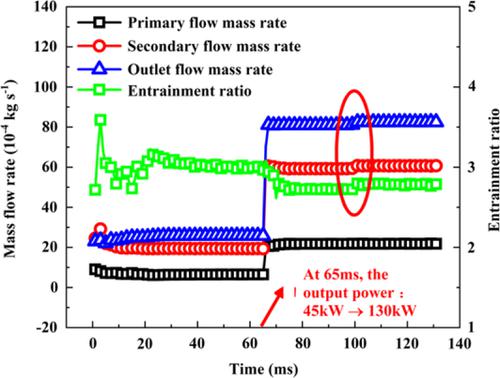当前位置:
X-MOL 学术
›
Int. J. Energy Res.
›
论文详情
Our official English website, www.x-mol.net, welcomes your
feedback! (Note: you will need to create a separate account there.)
Numerical investigation of ejector transient characteristics for a 130‐kW PEMFC system
International Journal of Energy Research ( IF 4.3 ) Pub Date : 2020-01-28 , DOI: 10.1002/er.5156 Zhanrui Liu 1 , Zhi Liu 1 , Kui Jiao 1 , Zirong Yang 1 , Xia Zhou 1 , Qing Du 1
International Journal of Energy Research ( IF 4.3 ) Pub Date : 2020-01-28 , DOI: 10.1002/er.5156 Zhanrui Liu 1 , Zhi Liu 1 , Kui Jiao 1 , Zirong Yang 1 , Xia Zhou 1 , Qing Du 1
Affiliation

|
Improvement of fuel utilization is an important issue for proton exchange membrane fuel cell (PEMFC) system. As a promising anode recirculation method, ejector has attracted great attention because it does not require additional power consumption. However, some transient processes such as the suck, diffusion, and mix of fluids are still not thoroughly revealed, which significantly influence ejector performances. In this study, a dynamic three‐dimensional (3D) multicomponent ejector model for a 130‐kW PEMFC system is developed. The model is validated against experimental data, including the entrainment ratio and mass flow rates. The effects of operating conditions (eg, pressure, water vapor, and nitrogen mass fraction) are investigated. The results show that the fuel supply can be controlled by the primary flow pressure. When the pressure difference between the primary and secondary flow is less than 10 kPa, the secondary flow cannot be sucked into the ejector. The transient response of ejector during stack power variations can be classified into two periods: the primary flow impact period and the mixed flow impact period. Under normal fuel cell system operating conditions, when the inlet relative humidity of the secondary flow is higher than 85%, the water vapor condensation is possible to happen at the ejector outlet region, leading to fuel supply instability. Besides, the hydrogen entrainment ratio decreases with the increase of nitrogen mass fraction. The effects of geometric parameters (eg, nozzle convergence angle, secondary flow tube diameter, mixing tube length, and diffuser angle) on ejector performances are also studied. It is found that the relatively short tube leads to pressure fluctuations in the vacuum region. Increasing the tube length is beneficial to creating a stable vacuum region. However, excessive tube length can increase the friction loss. Increasing the secondary flow inlet tube diameter is beneficial to the entrainment ratio. However, further enlarging the diameter contributes negligibly to the increase of entrainment ratio once the secondary flow mass rate depends on pressure.
中文翻译:

130kW PEMFC系统喷射器瞬态特性的数值研究
燃料利用率的提高是质子交换膜燃料电池(PEMFC)系统的重要问题。作为有希望的阳极再循环方法,喷射器由于不需要额外的功耗而备受关注。但是,某些瞬态过程(如流体的吸入,扩散和混合)仍然没有完全揭示出来,这会严重影响喷射器的性能。在这项研究中,为130kW PEMFC系统开发了动态三维(3D)多组分喷射器模型。该模型已针对包括夹带率和质量流率在内的实验数据进行了验证。研究了运行条件(例如压力,水蒸气和氮气质量分数)的影响。结果表明,可以通过一次流动压力来控制燃料供应。当一次和二次流量之间的压力差小于10 kPa时,二次流量将无法被吸入喷射器。喷射器在堆功率变化期间的瞬态响应可分为两个时期:主要流影响期和混合流影响期。在正常的燃料电池系统运行条件下,当二次流的入口相对湿度高于85%时,在喷射器出口区域可能会发生水蒸气冷凝,从而导致燃料供应不稳定。此外,氢的夹带率随着氮质量分数的增加而降低。还研究了几何参数(例如,喷嘴会聚角,二次流管直径,混合管长度和扩散器角度)对喷射器性能的影响。发现相对短的管导致真空区域中的压力波动。增加管长有利于建立稳定的真空区域。但是,过多的管长会增加摩擦损耗。增大二次流入口管的直径有利于夹带率。然而,一旦二次流动质量速率取决于压力,进一步增大直径对夹带率的增加的贡献可忽略不计。
更新日期:2020-01-28
中文翻译:

130kW PEMFC系统喷射器瞬态特性的数值研究
燃料利用率的提高是质子交换膜燃料电池(PEMFC)系统的重要问题。作为有希望的阳极再循环方法,喷射器由于不需要额外的功耗而备受关注。但是,某些瞬态过程(如流体的吸入,扩散和混合)仍然没有完全揭示出来,这会严重影响喷射器的性能。在这项研究中,为130kW PEMFC系统开发了动态三维(3D)多组分喷射器模型。该模型已针对包括夹带率和质量流率在内的实验数据进行了验证。研究了运行条件(例如压力,水蒸气和氮气质量分数)的影响。结果表明,可以通过一次流动压力来控制燃料供应。当一次和二次流量之间的压力差小于10 kPa时,二次流量将无法被吸入喷射器。喷射器在堆功率变化期间的瞬态响应可分为两个时期:主要流影响期和混合流影响期。在正常的燃料电池系统运行条件下,当二次流的入口相对湿度高于85%时,在喷射器出口区域可能会发生水蒸气冷凝,从而导致燃料供应不稳定。此外,氢的夹带率随着氮质量分数的增加而降低。还研究了几何参数(例如,喷嘴会聚角,二次流管直径,混合管长度和扩散器角度)对喷射器性能的影响。发现相对短的管导致真空区域中的压力波动。增加管长有利于建立稳定的真空区域。但是,过多的管长会增加摩擦损耗。增大二次流入口管的直径有利于夹带率。然而,一旦二次流动质量速率取决于压力,进一步增大直径对夹带率的增加的贡献可忽略不计。











































 京公网安备 11010802027423号
京公网安备 11010802027423号